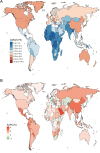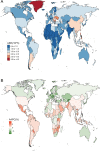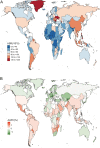The global, regional, and national early-onset colorectal cancer burden and trends from 1990 to 2019: results from the Global Burden of Disease Study 2019
- PMID: 36221047
- PMCID: PMC9555189
- DOI: 10.1186/s12889-022-14274-7
The global, regional, and national early-onset colorectal cancer burden and trends from 1990 to 2019: results from the Global Burden of Disease Study 2019
Abstract
Purpose: The incidence of early-onset colorectal cancer (EO-CRC), which occurs in people under age 50, has been increasing annually. The aim of this study was to provide an up-to-date estimate of the global EO-CRC burden.
Methods: We used Global Burden of Disease Study data and methodologies to describe changes in the EO-CRC burden from 1990 to 2019, including incidence, prevalence, mortality, and disability-adjusted life years (DALYs). The driving factors for cancer burden variation were further analyzed using decomposition analysis. Frontier analysis was used to visually demonstrate the potential for burden reduction in each country or region based on their development levels.
Results: The global EO-CRC incidence more than doubled, increasing from 95,737 (95% uncertainty interval (UI): 90,838-101.042) /100,000 in 1990 to 226,782 (95% UI: 207,495-248,604) /100,000 in 2019. Additionally, related deaths increased from 50,997 (95% UI: 47,692-54,410) /100,000 to 87,014 (95% UI: 80,259-94,339) /100,000, and DALYs increased from 256,1842 (95% UI: 239,4962-2,735,823) /100,000 to 4,297,573 (95% UI: 3,965,485-4,650,790) /100,000. Regarding age-standardized rates, incidence and prevalence increased significantly, while mortality and DALYs rate were basically unchanged. Decomposition analysis showed a significant increase in DALYs in the middle sociodemographic index (SDI) quintile region, in which aging and population growth played a major driving role. Frontier analysis showed that countries or regions with a higher SDI quintile tend to have greater improvement potential.
Conclusion: The current EO-CRC burden was found to be the greatest in the high-middle SDI quintile region and East Asia, which may need to adjust screening guidelines accordingly and introduce more effective interventions.
Keywords: Disability-adjusted life years (DALYs); Early-onset colorectal cancer (EO-CRC); Global Burden of Disease (GBD); Incidence; Mortality; Prevalence.
© 2022. The Author(s).
Conflict of interest statement
The authors declare that the research was conducted in the absence of any commercial or financial relationships that could be construed as a potential conflict of interest.
Figures








References
-
- Vuik FE, Nieuwenburg SA, Bardou M, Lansdorp-Vogelaar I, Dinis-Ribeiro M, Bento MJ, Zadnik V, Pellisé M, Esteban L, Kaminski MF, et al. Increasing incidence of colorectal cancer in young adults in Europe over the last 25 years. Gut. 2019;68(10):1820–1826. doi: 10.1136/gutjnl-2018-317592. - DOI - PMC - PubMed
Publication types
MeSH terms
LinkOut - more resources
Full Text Sources
Medical

